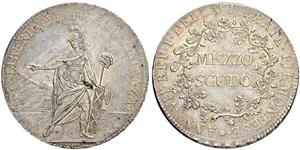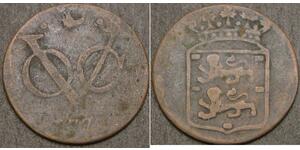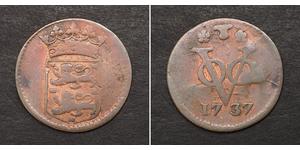(продана за $255.0)
1622, Milan (Duchy), Philip III of Spain. Large Silver Ducatone Coin. R!
Mint Place: Milan (Italy)
Denomination: Ducatone
Mint Period: 1622, 1625 or 1630 (date below bust not recognizable!)
Condition: Corrosion scars, dark oxidation deposits, otherwise VF-aXF!
Reference: Davenport 4001, Crippa 9, KM-43 ($375 in F / $650 in VF!). Rare!
Diameter: 41.5mm
Weight: 31.38gm
Material: Silver
Obverse: Radiate and armored and high-collared bust of Philip IV of Spain right, wearing Toison d'Or (Golden Fleece) Order on breastplate.
Comment: Face decoration inside shoulder drapery!
Legend: PHILIPPVS • IIII • REX • HISPAN •
Reverse: Coat-of-arms of the Duchy of Milano within ornate frame, topped by ducal crown containing two palm fronds.
Legend: • DVX • ETC • MEDIOLANI •
Ducatons were issued in the Spanish Netherlands and associated states (including the bishopric of Liege and Franche Comte) during the sixteenth and seventeenth centuries, where they competed with French écus, German talers and Dutch daalders and ducatons. The type shown here was struck at Milan 1622-30 for Philip IV of Spain. The series is plagued by bad planchets and poor strikes, reducing their appeal to collectors. The Spanish issues for Milan ended with the death of Charles II in 1700, when the duchy passed to Austria, which held it until the coming of Napoleon.
Philip IV (Felipe IV, (8 April 1605 – 17 September 1665) was King of Spain between 1621 and 1665, sovereign of the Spanish Netherlands, and King of Portugal until 1640. On the eve of his death in 1665, the Spanish empire reached its historical zenith spanning almost 3 billion acres.
Philip IV was born in Valladolid, and was the eldest son of Philip III and his wife Margaret of Austria.
Philip IV's reign, after a few years of inconclusive successes, was characterized by political and military decay and adversity. He has been held responsible for the decline of Spain, which was mostly due, however, to organic causes largely beyond the control of any one ruler. Philip certainly possessed more energy, both mental and physical, than his diffident father. His handwritten translation of Francesco Guicciardini's texts on political history still exists, and he was a fine horseman and keen hunter.
His artistic taste is shown by his patronage of his court painter Diego Velázquez; his love of letters by his favoring Lope de Vega, Pedro Calderón de la Barca, and other immortal dramatists. He is credited, on fairly probable testimony, with a share in the composition of several comedies. He also commenced the building of the Buen Retiro palace in Madrid, parts of which still remain near the Prado.
His good intentions were no avail to governance, however. Feeling himself not yet qualified to rule when he ascended to the throne at age 16, he allowed himself to be guided by the most capable men he could find. His favourite, Olivares, was a far more honest and capable man than his predecessor the Duke of Lerma, and better fitted for the office of chief minister than any Spaniard of the time, perhaps. Philip, however, lacked the confidence to free himself from Olivares's influence once he did come of age. With Olivares's encouragement, he rather busied himself with frivolous amusements.
In December 1st, 1640, a uprising took place in Lisbon expelling King Philip IV of Spain (Philip III of Portugal) from the Portuguese throne, giving it to the Braganzas. This was the end of 60 years of the Iberian Union and the beginning of the Portuguese Restoration War (lost by the Habsburgs).
By 1643, when disasters falling on all sides led to the dismissal of the all-powerful minister, Philip had largely lost the power to devote himself to hard work. After a brief struggle with the task of directing the administration of the most extensive and worst-organized multi-national state in Europe, he sank back into indolence and let other favourites govern.
His political opinions were those he had inherited from his father and grandfather. He thought it his duty to support the House of Habsburg and the cause of the Roman Catholic Church against the Protestants, to assert his sovereignty over the Dutch, and to extend the dominions of his family. The utter exhaustion of his people in the course of perpetual war, against the Netherlands, France, Portugal, Protestant forces in the Holy Roman Empire and Great Britain, was seen by him with sympathy but he considered it an unavoidable misfortune, since he could not have been expected to renounce his legitimate rights, or to desert what he viewed as the cause of God, the Church and the House of Habsburg.
He was idealised by his contemporaries as the model of Baroque kingship. Outwardly he maintained a bearing of rigid solemnity, and was seen to laugh only three times in the course of his entire public life. But, in private, his court was grossly corrupt. Victorian historians prudishly attributed the early death of his eldest son, Baltasar Carlos, to debauchery, encouraged by the gentlemen entrusted by the king with his education. This shocked the king, but its effect soon wore off. Philip IV died broken-hearted in 1665, expressing the pious hope that his surviving son, Carlos, would be more fortunate than himself. On his death, a catafalque was built in Rome to commemorate his life.

|
Добавив:
anonymous 2015-09-21 |
1/2 Скудо Папська держава (752-1870) Срібло
в групі 3 монет / 3 цін
⇑
1 Duit Нідерланди Мідь
в групі 18 монет / 17 цін
⇑

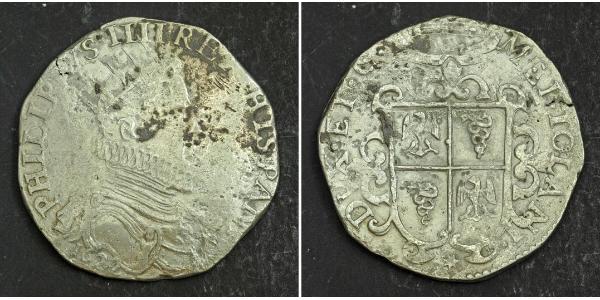





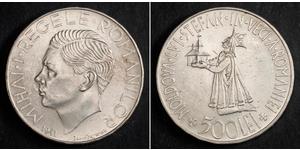




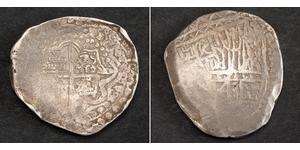
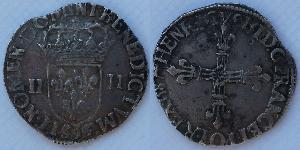

-300-150-hMc22nImZq0AAAF45igcj4bn.jpg)
